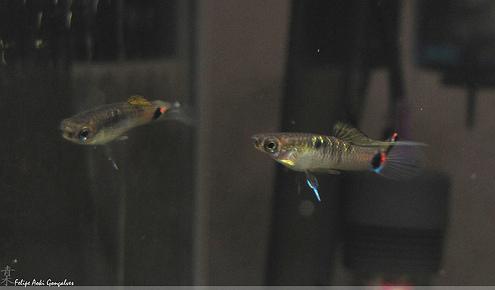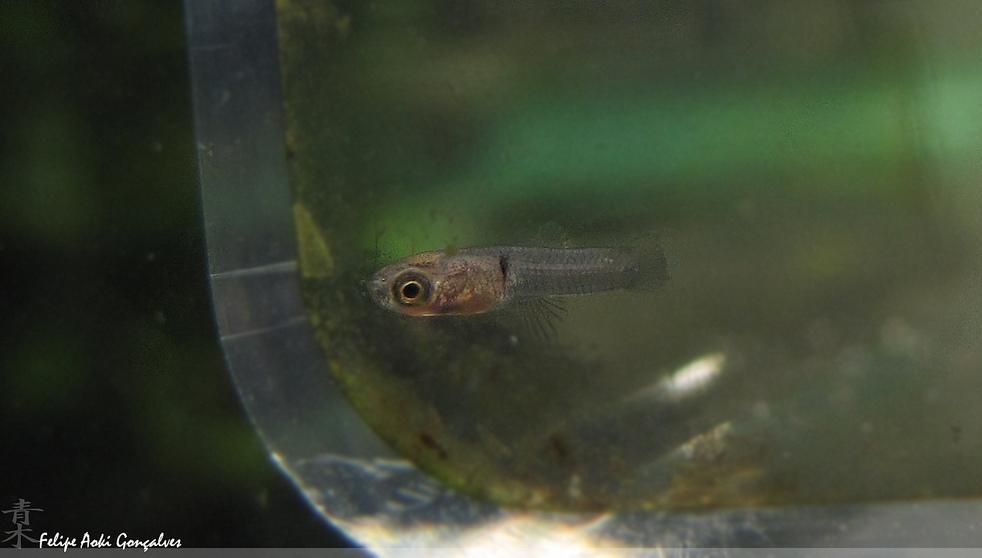Cyprinodontiformes vivíparos e ovovivíparos
Livebearer Cyprinodontiformes
Artigos - Micropoecilia cf. branneri “ Parnaíba ”
Articles - Micropoecilia cf. branneri “ Parnaíba ”
|
|
|
Cyprinodontiformes vivíparos e ovovivíparos Livebearer Cyprinodontiformes Artigos - Micropoecilia cf. branneri “ Parnaíba ” Articles - Micropoecilia cf. branneri “ Parnaíba ” |
||||||||||||||
|
|
|
Micropoecilia cf. branneri “ Parnaíba ” Felipe Aoki Gonçalves - published at this website in November 2009 |
|
|
Native from North-western Brazil, this splendid species is among the most interesting classified on the Poecilidae family. This is another notable example of variability within a single species, in both sexes, a fact that is however not so ordinary among other Poeciliids. In fact, usually there is some polymorphism, variability or both, between males of some species, but generally females are quite pale and identical from population to population and within them. Females of this species do exhibit the classical round belly shape, common to the majority of the ovoviviparous Poeciliids. Nevertheless they have a leaf-shape distinguish a caudal fin as well as a golden broad glow mixed with a light green spark. Another typical attribute are the two very defined false “ ocellus “, the first one, with more metallic bright pasty white on the clear area, situated on the flank right above the abdomen, and another one with a bright yellow on the clear area, located at the extreme of the caudal peduncle.
After the first “
ocellus “ females can show also some bars, varying in darkness or
perceptible visibility according to each animal’s distinguishing and
it’s position on the group’s hierarchy. |
|
|
|
Micropoecilia cf. branneri “ Parnaíba ” males generally display a golden dorsal pear shape fin, with a black margin, sometimes so long that in fact it goes as far as the caudal fin edge. Males are more slender than females and coloration can often be very variable among them, in particular due to age or hierarchy position inside the group. The less large males show a number of thin dark lists on the flank, no doubt more perceptible than in females, but share with them the very defined false “ ocellus “ in the same positions. Even so, in males the first one show less metallic scales on the periphery, while the second one links with caudal fin the superior border, after a glorious bar including some tones of green, red, yellow, blue and black. Oddly, the group dominant males show a single false “ ocellus “ located at the caudal peduncle, fallowed by same colours sequence. On these males in particular, the thin dark lists on the flank are absent, unless under some particular light reflexions or luminosity exposures. Such males compensate some less conspicuous dark lists or the absence of one of the false “ ocellus “ by a captivating golden and copperiest radiance on their entire body, as well as numerous metallic reflex scales, concentrated predominantly at the fish body dorsal region. |
|
Lower status male. |
Dominant male. |
 A clash between two males of lower status.
It’s easy to find who the prevailing one
will be. |
Colouration is not the only distinguish feature of this species. First and foremost when compared with other Poeciliid ordinary pet fish there is in fact some relevant behavioural uniqueness. On each group it soon becomes evident a hierarchy, achieved and maintained through clashes and duels between fish, but merely between opponents of the same gender. After an initial belligerence, following the pecking order establishment, females rarely wrestle again. Also confrontations between males will become slowly reduced after succeeding the set of clear dominance. Only than, the belligerency among males is gradually reduced to a few persecutions from the “ alpha “ male, and his next partners, to subjugated individuals, more close to the “ omega” male. From time to time there are still some occasional disputes going on. The breeding conduct is also noteworthy. This species’ females are not completely passive on the subject of mating. They are quite selective regarding males, and I was able to testify some rare courtship advances from females towards a dominant male, even if the opposite is the typical conduct.
The male’s nuptial dance
is quite unusual: he usually exhibits himself in front of the pretended
female for a short period, just before running after her with is
gonopodium already in position for copulation. |
|
Every now and then, the courtship includes a different approaching to the female on the display process. The male is than so close that is able to give some light “ love nibbles “ on her head. The gestation period is quite predictable, but keep in mind that we are in the presence of a superfetation species, as the offspring are released in small numbers ( from 1 to 3 daily ), even though mating is in fact extremely repeated. Birth occurs often in a dense floating vegetation cover, mainly among roots, as well as in the shallow water thickness right above immersed foliage near the surface. Newborn are generally 2-3 mm long and show vestiges of the yolk sac. During this stage they are quite vulnerable to infections. Adult fish show voracious cannibalistic tendencies, and seek for newborn enthusiastically in order to prey on them. For broaden the next generation survival I use a dense Riccia fluitans covering on the tank, which allows a good safe even, from newly born baby fish just up to the size they don’t have to fear adults. Such bryophytes form a dense entanglement, impenetrable for adults chasing the little ones. This plant has the advantage of allowing a good view of the young, as there are no immerse foliage covering the presence of the tiny fish. |
|
 Newborn with little more than a day of live. |
|
|
A week old little fry. |
The species survival ability is frankly noticeable, even on small fry. Take a look on this image. The prey, comparatively large, could not escape. The little fish was capable of devouring the Daphnia shown on the image. |
|
My fish are from “ Lagoa da Prata “, at Paranaíba River hydrographical basin.
I did not collect them.
It was my good friend Carlos Eduardo de P. Ribeiro. This way I will only
illustrate this article with his pictures from the wonderful lagoon,
original biotope of my Micropoecilia cf. branneri “ Parnaíba ”. |
|
|
The laggon’s satellite image. |
The lagoon’s general view. |
|
Another general view. |
The collecting spot. |
|
According to my friend Carlos Ribeiro, the waters of the lagoon are full of “ arraias “ ( sting rays ), which can represent some danger to collectors. Fortunately nothing bad happened to him. I believe this is a very hard species. According to my source, there are populations thriving as well in acidic waters ( pH 6.2 ) as prosperous populations in alkaline environments ( pH 7.5). According to my experience in aquarium, the best colours are achieved with fish living in slightly acid water ( pH 6.8 ). Besides that I’ve realise that mating attempts are more frequent in such setting. Besides all that have been said, this is also a reasonably rustic species: following violent fights I had the opportunity to witness very injured males ( near death ) but, on the next morning, they seemed completely fresh and absolutely recovered, foraging intensively, as they usually do. I never saw such fast improving earlier in other species. Let me conclude expressing my gratitude to all those had encourage me to keep ovoviviparous species and, most of all, to my friend Carlos Eduardo de P. Ribeiro. Without such incentive and help it wouldn’t be possible to tryout this astonishing experience with such fantastic fish.
I hope to keep on with
the success with this breathtaking species ( after two months my group
had present me with roughly 50 new fry ), as well as to be able on
contribute to a increased popularity of Micropoecilia branneri,
spreading as much as possible of them by other hobbyists.
Felipe Aoki Gonçalves. |
|
|
© 2006 - 2011 All Rights Reserved e-mail : viviparos.com
While the content is in the public domain, some pages contain images and material that are copyrighted by others and used here with permission. Such information is available for private use, study or research. You should obtain permission from the copyright owner for other uses. Please carefully examine all the content and all linked pages for copyright restrictions and to secure the necessary permissions.
These data and information are provided with the understanding that they are not guaranteed to be correct or complete. Users are cautioned to consider carefully the provisional nature of these data and information before using them; such data and information are the singular responsibility of the user. |